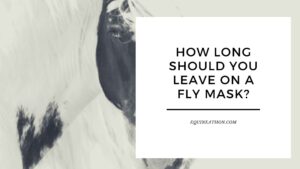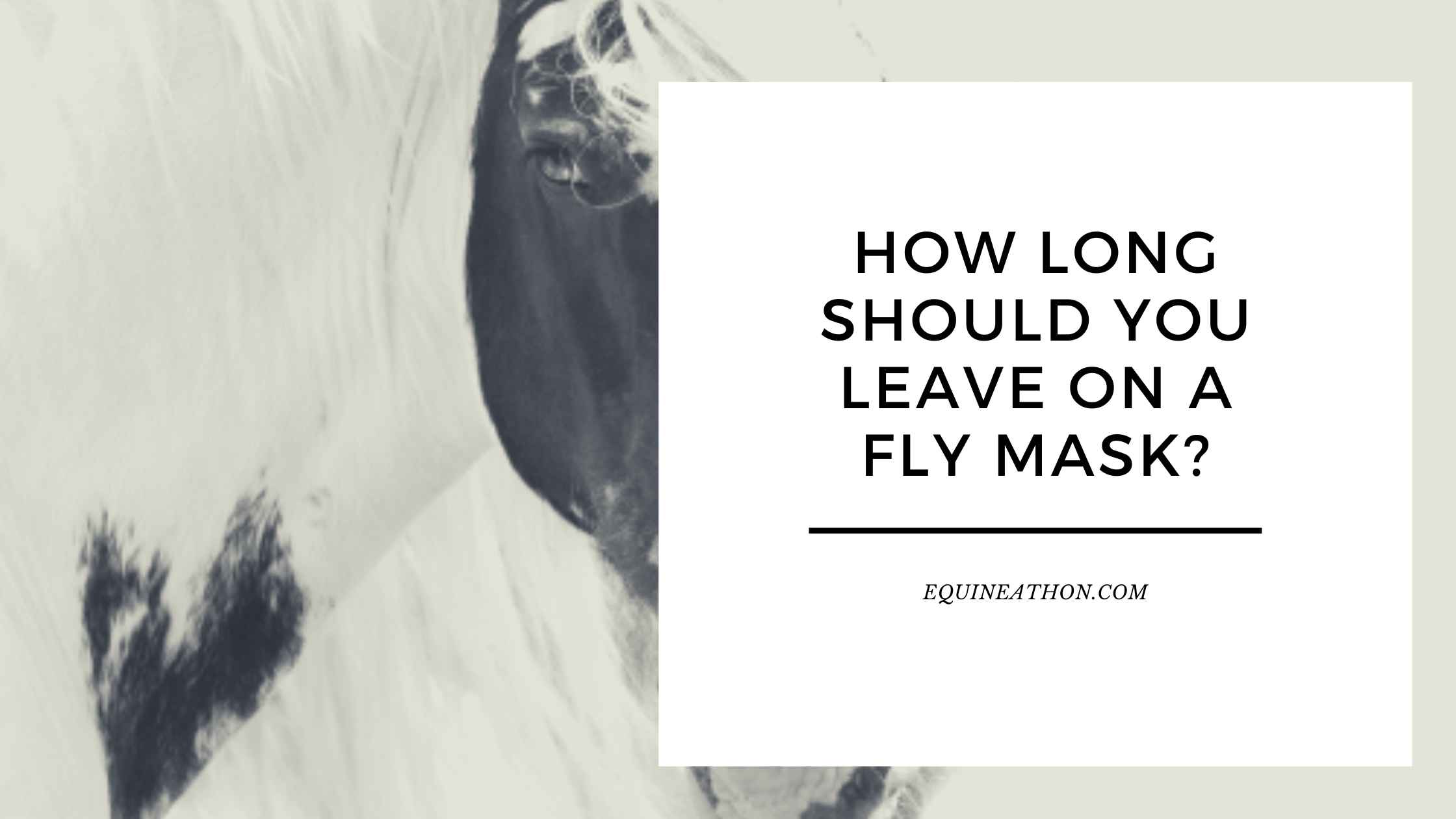How Long Should You Leave on a Fly Mask? The Complete Guide
Fly masks are an excellent addition to any horse owner’s toolkit, especially when it comes to offering horses protection from pesky flies, UV rays, and dust.
But how long should a fly mask stay on? As with many aspects of horse care, the answer isn’t just black and white. Let’s delve deeper.
Understanding the Purpose of a Fly Mask
Before we get to the “how long,” it’s essential to understand the “why.” Fly masks serve several critical functions:
- Protection from Flies: As their name suggests, fly masks primarily shield horses from flies and other biting insects. These pests can irritate the horse, leading to distress, infections, or diseases.
- UV Protection: Many fly masks come with UV protection, helping to shield horses, especially those with sensitive eyes or lighter pigmentation, from the harmful effects of the sun.
- Dust and Debris Barrier: Masks can also protect a horse’s eyes and ears from dust and other airborne debris, especially in windy environments or during specific activities.
Determining the Duration
1. Daytime Usage: If you’re using the fly mask to protect your horse from flies during peak fly activity hours, which are typically in the daytime, it makes sense to have the mask on during this period. Some horse owners opt to put it on in the morning and take it off in the evening, similar to our daily routine with sunglasses!
2. Nighttime: Generally, it’s advisable to remove the fly mask during the night, especially if the mask is not a clear mesh. This is because horses’ nocturnal vision might be impaired by a dark or colored mesh, making it harder for them to navigate and potentially leading to injuries.
3. 24/7 Wear: Some horses might require a more prolonged mask wear, especially those with specific health concerns or during peak fly season. In such cases, ensure the mask is designed for extended wear, offers clear vision during nighttime, and is checked regularly for any signs of wear and tear or discomfort.
Factors to Consider:
1. Individual Needs: Some horses are more bothered by flies than others. Observe your horse. If they seem agitated or are constantly trying to swat flies away, they’ll likely benefit from wearing their mask for more extended periods.
2. Environmental Conditions: In areas with dense fly populations or during specific seasons when flies are rampant, you might need to keep the mask on for longer durations.
3. Physical Health: Horses with eye or ear conditions, or those recovering from surgery, might require extended protection.
4. Type of Fly Mask: Ensure the fly mask is appropriate for the duration it’s being used. For instance, masks meant for extended wear should be breathable, provide clear vision, and fit comfortably without causing rubs or irritations.
Essential Tips:
- Regular Checks: Regardless of how long you decide to keep the fly mask on, it’s crucial to check regularly. Look for any signs of irritation, ensure the mask is clean, and that there are no trapped insects inside.
- Cleaning: Clean the mask often. A dirty mask can cause more harm than good, leading to potential infections or irritations.
- Fit: A well-fitted mask is paramount. An overly tight mask can cause rubs, while a loose one might allow flies to enter or could be easily removed by the horse.
- Training: Some horses might be wary of the mask initially. It’s essential to introduce it gradually, ensuring they are comfortable and associate it with positive experiences.
In Conclusion
The decision on how long to leave a fly mask on varies based on individual needs, environmental conditions, and the type of mask being used.
Regular checks, ensuring a proper fit, and maintaining cleanliness will ensure your horse gets the protection they need without any added complications.
Remember, the primary goal is the comfort and safety of your beloved equine friend.
ALSO SEE: Sucked up or Tucked up Flanks Near the Hip

FAQs on Fly Masks for Horses
1. What is the primary purpose of a fly mask?
- The primary purpose of a fly mask is to protect horses from flies and other biting insects.
2. Can fly masks offer protection against UV rays?
- Yes, many fly masks come with UV protection to shield horses from the harmful effects of the sun.
3. Do fly masks also protect against dust?
- Yes, fly masks can act as a barrier against dust and other airborne debris.
4. When is the peak fly activity period?
- Peak fly activity hours are typically in the daytime.
5. Should the fly mask be removed at night?
- It’s generally advisable to remove the fly mask during the night, especially if it isn’t made of clear mesh, to avoid impairing the horse’s nocturnal vision.
6. Is it safe for a horse to wear a fly mask 24/7?
- Some horses might require prolonged mask wear, especially during peak fly seasons. Ensure the mask is suitable for extended wear and offers clear vision at night.
7. How often should I check the fly mask?
- It’s crucial to check the fly mask regularly, looking for signs of wear and tear, discomfort, or trapped insects.
8. How can I ensure the fly mask is comfortable for my horse?
- Make sure the mask is breathable, provides clear vision, fits well, and doesn’t cause any rubs or irritations.
9. How should I introduce the fly mask to a wary horse?
- Introduce the mask gradually, ensuring the horse is comfortable and associates the mask with positive experiences.
10. Can a dirty fly mask cause infections?
- Yes, a dirty mask can potentially lead to infections or irritations.
11. How do I determine the right fit for a fly mask?
- A well-fitted mask shouldn’t be overly tight to cause rubs or too loose that flies can enter.
12. Are there specific fly masks for nighttime use?
- If you’re considering nighttime wear, look for masks designed for extended wear that offer clear vision during the night.
13. Why do some horses need to wear fly masks longer than others?
- Individual needs vary; some horses might be more bothered by flies or have specific health concerns that necessitate prolonged mask wear.
14. Should I be concerned about my horse’s vision when wearing a fly mask?
- Ensure the fly mask offers clear vision and doesn’t impair the horse’s ability to navigate, especially at night.
15. Can a fly mask be used for a horse recovering from surgery?
- Yes, especially if the horse requires extended protection for its eyes or ears.
16. How often should I clean the fly mask?
- Regular cleaning is vital. The frequency might depend on the environment, but it’s best to clean it often.
17. Can a fly mask cause rubs or irritation?
- If not fitted properly, an overly tight mask can cause rubs. Regular checks can help detect any signs of irritation early on.
18. Are there fly masks that come with ear covers?
- Yes, some fly masks are designed to cover both the eyes and ears for added protection.
19. Can flies get trapped inside the mask?
- If the mask is not fitted properly, there’s a chance flies could get trapped. Regular checks can help prevent this.
20. How do I know if my horse needs UV protection?
- Horses with sensitive eyes or lighter pigmentation might benefit more from UV protection.
21. Can I use a fly mask during riding sessions?
- There are specific fly masks designed for riding that provide clear vision and comfort during activity.
22. Are there any materials to avoid in fly masks?
- Choose materials that are breathable and gentle on the horse’s skin to prevent irritations.
23. Can I wash the fly mask in a washing machine?
- Check the care instructions. Many fly masks are machine-washable, but always follow the manufacturer’s guidelines.
24. Can a fly mask help a horse with an eye condition?
- Yes, especially if the condition makes the horse’s eyes more sensitive to light, dust, or flies.
25. How do I train my horse to wear a fly mask?
- Start slowly, introduce the mask gradually, and ensure each experience is positive.
26. Are fly masks suitable for foals?
- There are specific fly masks designed for younger horses. Ensure it fits properly and provides adequate protection.
27. Can a horse eat and drink comfortably with a fly mask on?
- Yes, the fly mask primarily covers the upper part of the face and doesn’t interfere with eating or drinking.
28. How do I determine if my horse is agitated by flies?
- Signs of agitation might include constantly trying to swat flies away or showing signs of distress.
29. Can I use a fly mask in combination with fly sprays?
- Yes, using both can provide comprehensive protection against flies.
30. Do fly masks come in different sizes?
- Yes, fly masks are available in various sizes to accommodate different breeds and ages of horses.
31. Are there any adverse effects of prolonged use of a fly mask?
- Prolonged use without regular checks can lead to undetected irritations or trapped debris. Always inspect the horse’s face and the mask frequently.
32. Are there fly masks for horses with unique facial features or markings?
- There are various designs available, but the primary focus should always be fit and protection.
33. How do I know when to replace a fly mask?
- If it shows signs of wear and tear, becomes too dirty, or no longer fits well, it’s time to replace it.
34. Are fly masks expensive?
- The cost varies depending on the brand, features, and material. However, there are options available for various budgets.
35. Can a fly mask be repaired if torn?
- Minor tears might be repaired, but if the integrity of the mask is compromised, it’s best to replace it.
36. How can I ensure the mask remains secure and the horse doesn’t remove it?
- Ensure a proper fit and check for any signs of discomfort that might make the horse want to remove it.
37. Is it essential to use a fly mask if I stable my horse during peak fly hours?
- It can be beneficial, especially if the stable has a fly problem, but it might be less critical than for horses that are outdoors during peak fly times.
38. Can a horse see clearly through the mesh?
- Yes, the mesh is designed to provide protection while allowing clear vision.
39. Should I be concerned about my horse getting too hot under the fly mask?
- Choose breathable materials, and ensure the horse doesn’t show signs of distress or overheating.
40. Can I customize a fly mask?
- Some companies offer customization, but always ensure that any additions or modifications don’t compromise the mask’s primary purpose: protection.


